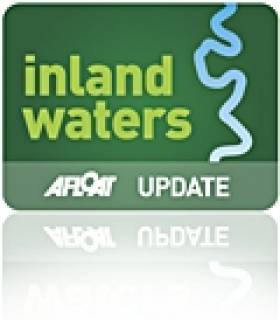Displaying items by tag: lough allen
The third phase of the Shannon Blueway has been opened by Michael Ring, Minister for Rural and Community Development, in the company of Waterways Ireland’s acting chief executive John McDonagh and Leitrim County Council Cathaoirleach Enda McGloin.
The project has created a new path along the shores of Lough Allen linking four tourism businesses to the lock at Blackrock and Drumshanbo town and increasing access for walkers, cyclists and horseriders.
This involved the upgrade of 1km of an existing pathway along the Lough Allen canal between Acres Cove Marina and Drumshanbo Lock at Blackrock, and the installation of a new controlled pedestrian crossing on the R208, the only road crossing on this section.
Car parking for 13 vehicles has also been created, with a new entrance to Drumshanbo Lock at Blackrock and the newly developed Blueway.
The new section of Blueway path runs north from this point along the shores of Lough Allen, and includes a pedestrian bridge across the Millrace River connecting the town with a range of existing amenities.
Funding for the project was obtained by a partnership of Waterways Ireland and Leitrim County Council under the Outdoor Recreational Infrastructure Scheme through the Department of Rural and Community Development.
A total of €340,000 of Outdoor Recreational Infrastructure funding has been match-funded with €86,000 by Waterways Ireland.
Minister Ring said: “I am delighted to launch Phase 3 of the Shannon Blueway here in Leitrim. This will build on the success of Phases 1 and 2 of this project which were supported by my Department and which have brought 100,000 new visitors to this rural area, creating opportunities for business growth, new businesses and jobs.
“Phase 3 links a further four existing business to the Blueway and will be instrumental in increasing the time and money people spend in this area. This has been a wonderful collaborative effort between my Department, Waterways Ireland and Leitrim County Council.”
John McDonagh added: “Blueways are an excellent way of linking the waterways and paths we manage with tourism businesses and recreation clubs providing opportunities for people to experience the outdoors, nature and adventure.”
Waterways Ireland says the Shannon Blueway has proved to be a catalyst for ongoing rural development, social inclusion and job creation, and had so far led to the establishment of eight water-based recreational businesses.
In 2018 alone, 100,000 visitors used the Blueway facilities at Acres Lake, which are utilised for numerous sporting and charitable events, as a community resource and public asset.
The opening in Leitrim comes in the same week as the launch of a new development guide and accreditation scheme for Blueway development on the island of Ireland.
This initiative sees a number of State agencies working in partnership on an all-island basis to see the development of Blueway sites in the Republic of Ireland and Northern Ireland over the coming years.
Shannon Sluice Gates Opened to Allay Flood Concerns
#INLAND WATERWAYS - Sluice gates have been opened at locks and dams along the River Shannon due to flooding concerns, The Irish Times reports.
The ESB confirmed that water levels in the upper Shannon had been rising significantly since September, and were just below those recorded prior to the flooding in Carrick-on-Shannon two years ago.
However the flooding threat has abated this week, with levels in Lough Allen dropping by around 300cm, although the situation is still subject to amounts of rainfall in the coming days as the Shannon drains slowly.
Levels in Lough Ree have also stabilised after rising throughout October.
The ESB continues to discharge from the Ardnacrusha power plant, while Waterways Ireland has commenced dredging at Meelick in Co Galway.
The Irish Times has more on the story HERE.
Marine Notice: Shannon Navigation
Shannon Navigation Lough Allen Drumshanbo Jetty Sunken Vessel
Waterways Ireland wishes to advise masters on the inland waterways that a vessel has sunk at the north end of Drumshanbo Lock jetty and poses a hazard to any vessel approaching or departing the jetty. Masters are requested to seek advice from the lockkeeper before berthing and to navigate with due caution.
Charles Lawn
Lt Cdr (rtd)
Inspector of Navigation
12 Jan 2011
Tel: 00 353 (0)90 6494232































































